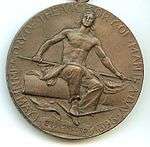Dewey Medal
| Battle of Manila Bay or "Dewey" Medal | |
|---|---|
|
Obverse | |
| Awarded by United States Department of the Navy | |
| Type | Commemorative medal |
| Eligibility | Officers and men of the ships of the Asiatic Squadron of the United States under the command of Commodore George Dewey |
| Awarded for | Participation in the Battle of Manila Bay on May 1, 1898 |
| Status | Obsolete |
| Statistics | |
| Established | June 3, 1898[1] |
| First awarded | 1898 |
| Order of Wear (1972) | |
| Next (higher) | Organized Marine Corps Reserve Medal[2] |
| Next (lower) | Sampson Medal[2] |
 Reverse and ribbon of the medal | |
The Dewey Medal was a military decoration of the United States Navy which was established by the United States Congress on June 3, 1898. The medal recognizes the leadership of Admiral of the Navy George Dewey, during the Spanish–American War, and the sailors and Marines under his command.[1]
Criteria
The Dewey Medal was created to recognize the forces of the U.S. Navy and United States Marine Corps who participated in the Battle of Manila Bay. To be awarded the Dewey Medal, a service member must have served on one of the following naval vessels on May 1, 1898:
- USS Baltimore
- USS Boston
- USS Concord
- USS McCulloch
- USS Nanshan
- USS Olympia
- USS Petrel
- USS Raleigh
- USS Zafiro
The Dewey Medal was a one-time only decoration and there were no devices or campaign stars authorized to the medal. The medal consists of a circular medallion, upon which rests an image of Admiral George Dewey, suspended from a blue and yellow ribbon. Admiral Dewey himself was awarded the medal, although he always wore it with the medal's reverse displayed which depicted a sailor sitting on a gun. Dewey had the rare distinction of being one of only four Americans entitled to wear a medal with their own image on it. The others were Rear Admiral William T. Sampson (Sampson Medal), Rear Admiral Richard E. Byrd (Byrd Antarctic Expedition Medal) and General of the Armies John J. Pershing (Army of Occupation of Germany Medal).
The medal was recognized as being given for active military duty; yet because it recognized a single battle in a single campaign, the Dewey Medal was a commemorative medal. When worn on a military uniform the Dewey Medal was considered senior to the Sampson Medal.[3]
Appearance
This medal was designed by celebrated artist Daniel Chester French, who sculpted the statue of a seated Lincoln in Washington's Lincoln Memorial and the "Minuteman" at Concord, Mass. The medal was struck by Tiffany & Co. The front, or obverse, depicts a bust of Commodore George Dewey. On the back, or reverse, is included the name of the vessel on which the recipient served. The name of the recipient is engraved on the medal's lower rim, this being one of only two service medals issued officially named to the recipient.[4]
References
- 1 2 United States Congress (1898).
 [No. 42.] Joint Resolution Authorizing the Secretary of the Navy to present a sword of honor to Commodore George Dewey, and to cause to be struck bronze medals commemorating the battle of Manila Bay, and to distribute such medals to the officers and men of the ships of the Asiatic Squadron of the United States.. Washington, DC: Government Printing Office. Wikisource. p. 746.
[No. 42.] Joint Resolution Authorizing the Secretary of the Navy to present a sword of honor to Commodore George Dewey, and to cause to be struck bronze medals commemorating the battle of Manila Bay, and to distribute such medals to the officers and men of the ships of the Asiatic Squadron of the United States.. Washington, DC: Government Printing Office. Wikisource. p. 746.  [scan]
[scan] - 1 2 The Code of Federal Regulations of the United States of America. Washington: Government Printing Office. 1972. p. 640.
- ↑ Bureau of Naval Personnel (1953). Navy and Marine Corps Awards Manual (NavPers 15,790, Rev 1953) (PDF). Washington, D.C.: Department of the Navy. p. 37.
- ↑ http://www.history.navy.mil/medals/dewey.htm
